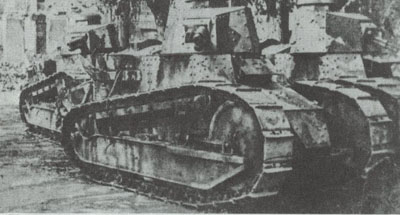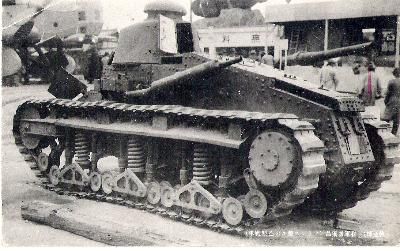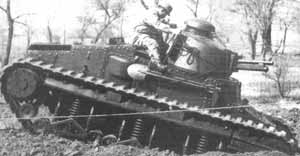Japanin ratsuväki kokeili erilaisia panssaroituja autoja ilman sanottavampaa menestystä.
Pyörillä liikkuvat panssaroidut autot eivät olleet paras vaihtoehto armeijan toimiin mantsuriassa koska tie-olosuhteet olivat huonot, tai hyvin puutteelliset, lisäksi ankara talvi ilmasto runsainen lumi-sateineen haittasi pyörillä liikkuvien autojen käyttöä.
Japanin armeija (kuten Yhdysvaltojen, Ranskan, Britannian ja Venäjän armeijat) kokeili erilaisia menetelmiä integroida modernit panssari perinteiseen hevosen rooliin ratsuväen käytössä ja kokoonpanoissa.
--------------------------------------------------------------------------------------------------------------
FT-Ko tankki. Kolmetoista tankkia ostettu ja kuljetettu japaniin 1919.
Käyttäjänä Japanin Keisarillinen Armeija.
Vaunujen aseistuksena Puteaux SA 18 tykki tai yksi konekivääri.
Japani käytti tankkeja Mantshurian tapahtumissa ja tämän jälkeen koulutus käytössä.
VENÄJÄN - JAPANIN SOTA Mantshuria
----------------------------------------------------------------------------------------------------------
After World War I, many European countries attempted to mechanize their cavalry. In parallel, Japanese cavalry also experimented with a variety of armored cars with limited success.
These wheeled armored cars were not suitable for most operations in Manchuria, due to the poor road conditions and severe winter climate. Na Sopkah Manchzhurii
--------------------------------------------------------------------------------------------------------------------------
History of Manchuria.
Inner Manchuria also came under strong Russian influence with the building of the Chinese Eastern Railway through Harbin to Vladivostok. In the Chuang Guandong movement, many Han farmers, mostly from the Shandong peninsula moved there. By 1921, Harbin, northern Manchuria's largest city, had a population of 300,000, including 100,000 Russians.
Japan replaced Russian influence in the southern half of Inner Manchuria as a result of the Russo - Japanese War in 1904–1905. Most of the southern branch of the Chinese Eastern Railway was transferred from Russia to Japan, and became the South Manchurian Railway. Japanese influence extended into Outer Manchuria in the wake of the Russian Revolution of 1917, but Outer Manchuria had reverted to Soviet control by 1925.
Japan Whippet tanks
A few (perhaps six) were exported to Japan, where they remained in service until around 1930
Battle of Lake Khasan
Manchuria was an important region for its rich mineral and coal reserves, and its soil is perfect for soy and barley production. For pre–World War II Japan, Manchuria was an essential source of raw materials. Without occupying Manchuria, the Japanese probably could not have carried out their plan for conquest over Southeast Asia or taken the risk to attack Pearl Harbor and the British Empire in 1941.
-----------------------------------------------------------------------------------------------------------------------
Japan's army (like the US, French, British and Russian armies) tried various methods to integrate modern armor into their traditional horse cavalry formations.
At the close of World War I, the Imperial Japanese Army obtained a variety of models from foreign sources.
The Japanese did not have any indigenous tank production capability and until they could set up the factories and infrastructure continued buying from foreign sources.
Near the end of World War I, the Japanese showed an interest in armored warfare and tanks and obtained a variety of models from foreign sources.
-------------------------
The Mk IV was purchased in October 1918 while the Whippets and Renaults were acquired in 1919.
--------------------------
These models included one British Heavy Mk IV and six Medium Mark A Whippets, along with thirteen French Renault FTs...


...later designated Ko-Gata Sensha or Type A Tank.
With this beginning, the Imperial Japanese Army establish an armored force in 1925.
The Imperial Japanese Army purchased the Renault FTs from France, and in 1929 when its replacement came out, they were able to acquire 10 of the Renault NC1...
...but this is another story, someday

...designated Otsu-Gata Sensha or Type B Tank.
Building tanks of their own met several problems, as Japan's priority tended to be with naval procurements so production for tank steel would have been on a lower level.
However they were able to finally get to actually designing the tanks by the mid-1920s.

And now they make most of the worlds cars!
VastaaPoistaYep
PoistaAnd a very flat quality, work well and is reliable.
But they also carry a great deal and very good diesel engines.
Isuzu is the world's largest manufacturer of diesel engines
bigger than the Mercedes-Benz
(the first V-8 diesel / isuzu)
There are not many excavator, (7.5 tons - 25 tons), who does not use the Isuzu engine
the second sign is Hino (Toyota heavy engine series).